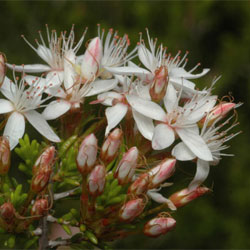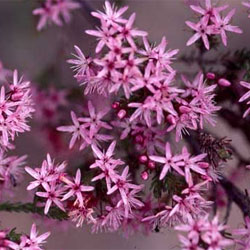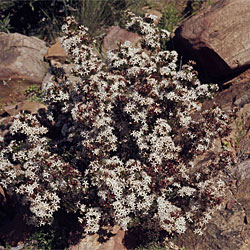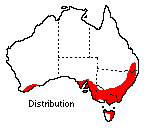Calytrix tetragona
 |
 |
 |
Common Fringe Myrtle
The genus Calytrix (Fringe Myrtles) is a beautiful group of shrubs belonging to the family Myrtaceae, found wild only in Australia. Some forty to fifty species have been recorded, mainly in Western Australia, but very few are yet in cultivation. The shrubs are of the type often described as heath-like, with small narrow leaves and thin lightweight branches, with aromatic foliage and young stems.
 The
fringed effect is given by the calyx which tapers into points behind each
five-petalled, starry flower, in the centre of which is a cluster of prominent
stamens. Like so many Australian shrubs, the form and quality of the flowers
and their arrangement on the stems are excellent.
The
fringed effect is given by the calyx which tapers into points behind each
five-petalled, starry flower, in the centre of which is a cluster of prominent
stamens. Like so many Australian shrubs, the form and quality of the flowers
and their arrangement on the stems are excellent.
Common Fringe Myrtle (Calytrix tetragona), the species described here, is widespread and variable throughout temperate Australia as a dwarf to tall shrub. It exists still as a wild flower around Canberra, though rare, on Black Mountain, site of the Australian National Botanic Gardens. In 1961 it was recorded in the Canberra district formerly known as Westlake on a slope resembling a natural rockery among Hibbertia, Dodonaea, Stypandra and other local species.
Calytrix tetragona is an easily grown and very hardy shrub for the small garden, usually reaching 1 m or more, although long-lived specimens grow taller: a 20-year-old plant at the Australian National Botanic Gardens has reached 2.5 m. To obtain a bushy plant of this size, watering and regular light prunings are needed to avoid bare wood.
The tiny leaves are slightly fleshy with a spicy perfume when bruised. The colour of a healthy shrub is bright green with yellow-green young tips.
For most of the year the appearance is neat but undistinguished until flowering in October. Flowers are white or pink, deeper in the pointed buds, clustered along the arching branches, sometimes massed and nearly hiding the leaves. A beautiful deep pink form collected near Keith in South Australia appears to have great potential as a garden subject. Cool, moist conditions extend the season of C. tetragona into December but this is not a species which has stray flowers all the year. Bees have been seen crowding around at flowering time.
After flowering, the calyces hang on for some weeks, shiny and saucer-shaped with long curling threads, turning golden bronze and purplish. The branches, now delicate and feathery, are as decorative as when they were in flower and will live in water almost until they dry out naturally. Propagation is by small cuttings of half-ripe tip growth.Young plants are generally available from nurseries dealing in native species.
A garden position in sun or light shade is suitable, in well-drained lime free soil. During a severe outbreak of root rot, worsened by rains when the soil was periodically soggy, Calytrix suffered badly and many plants died. Some plants which suffered partial die-back have since recovered to make new growth. No other diseases or pests have been noticed.
Based on text by ANBG staff (1972)
Name meaning: Calytrix tetragonaCalytrix - from two Greek words meaning calyx and hair, alluding to the long fine calyx tips; tetragona - four-sided, relating to the leaf cross-section |
![An Australian Government Initiative [logo]](/images/austgovt_brown_90px.gif)

